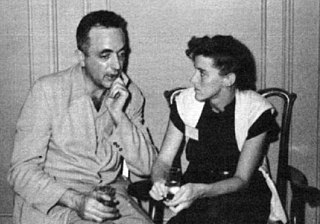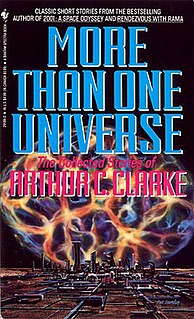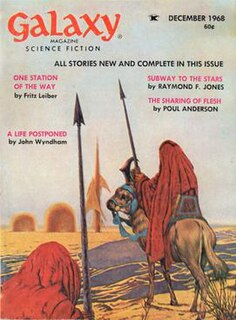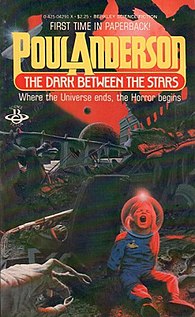Dan Simmons is an American science fiction and horror writer. He is the author of the Hyperion Cantos and the Ilium/Olympos cycles, among other works which span the science fiction, horror, and fantasy genres, sometimes within a single novel. A typical example of Simmons' intermingling of genres is Song of Kali (1985), winner of the World Fantasy Award. He also writes mysteries and thrillers, some of which feature the continuing character Joe Kurtz.

Fritz Reuter Leiber Jr. was an American writer of fantasy, horror, and science fiction. He was also a poet, actor in theater and films, playwright and chess expert. With writers such as Robert E. Howard and Michael Moorcock, Leiber can be regarded as one of the fathers of sword and sorcery fantasy, having coined the term.

Pat Cadigan is an American science fiction author, whose work is most often identified with the cyberpunk movement. Her novels and short stories all share a common theme of exploring the relationship between the human mind and technology.

Robert "Bob" Shaw was a science fiction writer and fan from Northern Ireland, noted for his originality and wit. He won the Hugo Award for Best Fan Writer in 1979 and 1980. His short story "Light of Other Days" was a Hugo Award nominee in 1967, as was his novel The Ragged Astronauts in 1987.

"Nightfall" is a 1941 science fiction novelette by American writer Isaac Asimov about the coming of darkness to the people of a planet ordinarily illuminated by sunlight at all times. It was adapted into a novel with Robert Silverberg in 1990. The short story has been included in 48 anthologies, and has appeared in six collections of Asimov's stories. In 1968, the Science Fiction Writers of America voted "Nightfall" the best science fiction short story written prior to the 1965 establishment of the Nebula Awards, and included it in The Science Fiction Hall of Fame Volume One, 1929-1964.
Stanley Albert Schmidt is an American science fiction author. Between 1978 and 2012 he served as editor of Analog Science Fiction and Fact magazine.

"Call Me Joe" is a science fiction novelette by American writer Poul Anderson, published in Astounding Science Fiction in April 1957. It later appeared in Anderson's 1981 collection The Dark Between the Stars. The Science Fiction Writers of America selected "Call Me Joe" for The Science Fiction Hall of Fame, Volume Two.
"Eutopia" is a short story by American writer Poul Anderson, originally appeared in Harlan Ellison's 1967 science fiction anthology Dangerous Visions. It later appeared in Anderson's 1981 collection The Dark Between the Stars and the showcase The Best Alternate History Stories of the 20th Century (2001).

"The Crystal Egg" is a science fiction short story written by H. G. Wells in 1897.

Three Hearts and Three Lions is a 1961 fantasy novel by American writer Poul Anderson, expanded from a 1953 novella by Anderson which appeared in Fantasy & Science Fiction.
A fix-up is a novel created from several short fiction stories that may or may not have been initially related or previously published. The stories may be edited for consistency, and sometimes new connecting material, such as a frame story or other interstitial narration, is written for the new work. The term was coined by the science fiction writer A. E. van Vogt, who published several fix-ups of his own, including The Voyage of the Space Beagle, but the practice exists outside of science fiction. The use of the term in science fiction criticism was popularised by the first (1979) edition of the Encyclopedia of Science Fiction, edited by Peter Nicholls, which credited van Vogt with the creation of the term. The name comes from the modifications that the author needs to make in the original texts to make them fit together as though they were a novel. Foreshadowing of events from the later stories may be jammed into an early chapter of the fix-up, and character development may be interleaved throughout the book. Contradictions and inconsistencies between episodes are usually worked out.

The Psychotechnic League is a future history created by American science fiction writer Poul Anderson. The name "Psychotechnic League" was coined by Sandra Miesel in the early 1980s, to capitalize on Anderson's better-known Polesotechnic League future history. Anderson published 21 novels, novellas and short stories set in this future between 1949 and 1957, with a 22nd published in 1968.

Between the Strokes of Night (1985) is a science fiction novel by Charles Sheffield. It first appeared in the March to June 1985 issues of Analog Science Fiction/Science Fact before being published by Baen Books in July 1985. The story is divided in two vastly separated time periods: the near future of 2010, and the far future of 29,000 AD. Due to the unique technological mechanisms of the novel, the same cast of characters appears in both parts, though it is not a time travel story.

More Than One Universe: The Collected Stories of Arthur C. Clarke is a collection of science fiction short stories by Arthur C. Clarke originally published in 1991.

"The Sharing of Flesh" is a science fiction novelette by American writer Poul Anderson. Originally published in Galaxy Science Fiction, it won a 1968 Hugo Award for Best Novelette and was nominated for a 1969 Nebula Award. The story has appeared in the collections The Night Face & Other Stories (1979), The Dark Between the Stars (1981), Winners (1981), and The Long Night (1983).

The Saga of Shadows is a trilogy of space opera novels written by Kevin J. Anderson. First announced in 2011, it is a sequel to Anderson's seven-book series, The Saga of Seven Suns (2002–2008). The first novel, The Dark Between the Stars, was released by Tor Books on June 3, 2014. The second book in the series, Blood of the Cosmos, was published on June 2, 2015. The third novel, called Eternity's Mind, was released on September 13, 2016.

The Dark Between the Stars is a 1981 collection of previously-published science fiction short stories by American writer Poul Anderson.

The following is a list of works by science fiction and fantasy author Poul Anderson.
Mildred Downey Broxon is an American science fiction and fantasy author.

















